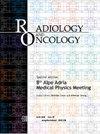体外可逆电穿孔后磁共振造影剂夹带分析。
IF 2.1
4区 医学
Q3 ONCOLOGY
引用次数: 0
摘要
背景在电穿孔前使用钆基造影剂可使造影剂进入细胞,并对可逆电穿孔区域进行磁共振成像评估。本研究的目的是评估造影剂在中国仓鼠卵巢(CHO)细胞中的截留情况,并将这些结果与评估电穿孔后细胞膜通透性、细胞膜完整性和细胞存活率的标准体外方法所确定的结果进行比较。细胞存活实验采用 MTS 检测法评估细胞的代谢活性。电穿孔 25 分钟和 24 小时后,使用细胞悬浮液的 T1 弛豫测定法评估了细胞内钆基造影剂钆布醇的夹带情况,并通过电感耦合等离子体质谱法进行了确认。电感耦合等离子体质谱法显示,随着 T1 松弛时间的缩短,每个细胞中的钆含量成比例减少(R 2 = 0.结论我们的研究结果表明,造影剂被包裹在暴露于可逆电穿孔的细胞中,但在 24 小时内从暴露于不可逆电穿孔的细胞中排出,从而证实了体内检测实验所依据的假设。本文章由计算机程序翻译,如有差异,请以英文原文为准。
Analysis of magnetic resonance contrast agent entrapment following reversible electroporation in vitro.
BACKGROUND
Administering gadolinium-based contrast agent before electroporation allows the contrast agent to enter the cells and enables MRI assessment of reversibly electroporated regions. The aim of this study was evaluation of contrast agent entrapment in Chinese hamster ovary (CHO) cells and comparison of these results with those determined by standard in vitro methods for assessing cell membrane permeability, cell membrane integrity and cell survival following electroporation.
MATERIALS AND METHODS
Cell membrane permeabilization and cell membrane integrity experiments were performed using YO-PRO-1 dye and propidium iodide, respectively. Cell survival experiments were performed by assessing metabolic activity of cells using MTS assay. The entrapment of gadolinium-based contrast agent gadobutrol inside the cells was evaluated using T1 relaxometry of cell suspensions 25 min and 24 h after electroporation and confirmed by inductively coupled plasma mass spectrometry.
RESULTS
Contrast agent was detected 25 min and 24 h after the delivery of electric pulses in cells that were reversibly electroporated. In addition, contrast agent was present in irreversibly electroporated cells 25 min after the delivery of electric pulses but was no longer detected in irreversibly electroporated cells after 24 h. Inductively coupled plasma mass spectrometry showed a proportional decrease in gadolinium content per cell with shortening of T1 relaxation time (R 2 = 0.88 and p = 0.0191).
CONCLUSIONS
Our results demonstrate that the contrast agent is entrapped in cells exposed to reversible electroporation but exits from cells exposed to irreversible electroporation within 24 h, thus confirming the hypothesis on which detection experiments in vivo were based.
求助全文
通过发布文献求助,成功后即可免费获取论文全文。
去求助
来源期刊

Radiology and Oncology
ONCOLOGY-RADIOLOGY, NUCLEAR MEDICINE & MEDICAL IMAGING
CiteScore
4.40
自引率
0.00%
发文量
42
审稿时长
>12 weeks
期刊介绍:
Radiology and Oncology is a multidisciplinary journal devoted to the publishing original and high quality scientific papers and review articles, pertinent to diagnostic and interventional radiology, computerized tomography, magnetic resonance, ultrasound, nuclear medicine, radiotherapy, clinical and experimental oncology, radiobiology, medical physics and radiation protection. Therefore, the scope of the journal is to cover beside radiology the diagnostic and therapeutic aspects in oncology, which distinguishes it from other journals in the field.
 求助内容:
求助内容: 应助结果提醒方式:
应助结果提醒方式:


